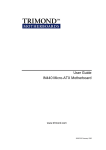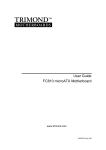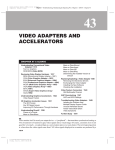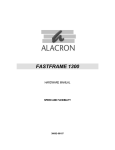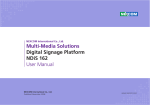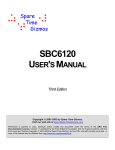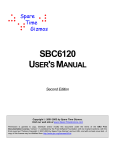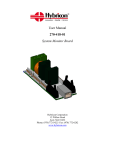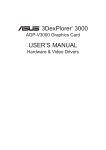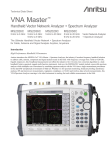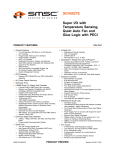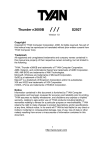Download Mitsubishi Electric PH440 User guide
Transcript
MOTHERBOARD DIVISION User Guide PH440 NLX Motherboard www.mitsubishi-motherboard.com 124577UG September 1998 PH440 NLX Motherboard User Guide September 1998 Document History Issue Description Date 1.0 Preliminary May 98 1.1 Update for production motherboards July 98 1.2 Style update, added installation and upgrade guides September 98 Trademarks mentioned within this document are the properties of their respective owners. Details available on request. Information contained in this document is subject to change without notice and does not represent a commitment on the part of Mitsubishi Electric Motherboard Division. No part of this manual may be reproduced or transmitted in any form or by any means electronic or mechanical including photocopying and recording, for any purpose, without the express written permission of the publishers. Published by: Mitsubishi Electric Motherboard Division 3500 Parkside Birmingham Business Park Birmingham, England B37 7YS MITSUBISHI ELECTRIC MOTHERBOARD DIVISION PAGE 2 OF 51 PH440 NLX Motherboard User Guide September 1998 SAFETY AND REGULATORY NOTICES GENERAL Battery This product contains a lithium battery. Do not use a metal or other conductive implement to remove the battery. If a short-circuit is made between its positive and negative terminals the battery may explode. Replace a discharged battery with one of the same type; another type may explode or ignite. Follow the instructions contained in the User Guide to replace the battery. Dispose of a discharged battery promptly and in accordance with the battery manufacturer’s recommended instructions. Do not recharge, disassemble or incinerate the discharged battery. Keep away from children. Anti-static precautions Warning Static electricity can cause permanent damage to electronic components. You should be aware of this risk, and take precautions against the discharge of static electricity. This product is at risk from static discharge because the electronic components of the motherboard are exposed. Memory modules and replacement processors are examples of electrostatic sensitive devices (ESSDs). All work that involves contact with the PH440 NLX Motherboard should be done in an area completely free of static electricity. We recommend using a Special Handling Area (SHA) as defined by EN 100015-1: 1992. This means that working surfaces, floor coverings and chairs must be connected to a common earth reference point, and you should wear an earthed wrist strap and anti-static clothing. It is also a good idea to use an ionizer or humidifier to remove static from the air. Handle static-sensitive items with extreme care. Hold add-on components only by their edges, avoiding their electrical contacts. In general, do not handle static-sensitive items unnecessarily. Keep all conductive material, and food and drink, away from your work area and PH440 NLX Motherboard. LEGALITIES This product complies with the relevant clauses of the following European Directives (and all subsequent amendments): Low Voltage Directive 73/23/EEC EMC Directive 89/336/EEC CE Marking Directive 93/68/EEC Important This product, when supplied, complies with the CE Marking Directive and its strict legal requirements. Use only parts tested and approved by Mitsubishi Electric Motherboard Division. MITSUBISHI ELECTRIC MOTHERBOARD DIVISION PAGE 3 OF 51 PH440 NLX Motherboard User Guide September 1998 STANDARDS Safety This product complies with the American Safety Standard UL1950. Electro-magnetic Compatibility (EMC) This product complies with the following European EMC standards: Emissions EN50022 Class B Immunity EN50082-1 Class B This product also complies with the following American EMC standard: FCC Class B FCC Compliance Statement Note: This equipment has been tested and found to comply with the limits for a Class B digital device, pursuant to part 15 of the FCC Rules. These limits are designed to provide reasonable protection against harmful interference in a residential installation. This equipment generates, uses and can radiate radio frequency energy and, if not installed and used in accordance with the instructions, may cause harmful interference to radio communications. However, there is no guarantee that interference will not occur in a particular installation. If this equipment does cause harmful interference, which can be determined by turning the equipment off and on, the user is encouraged to try to correct the interference by one or more of the following measures: ♦ Reorient or relocate the receiving antenna. ♦ Increase the separation between the equipment and receiver. ♦ Connect the equipment into an outlet on a circuit different to that which the receiver is connected. ♦ Consult the dealer or an experienced radio/TV technician for help. Important You are cautioned that any change or modification to the product not expressly approved by the manufacturer could void the approvals held by this product. MITSUBISHI ELECTRIC MOTHERBOARD DIVISION PAGE 4 OF 51 PH440 NLX Motherboard User Guide September 1998 CONTENTS 1 Overview 8 Motherboard Features ...................................................................................................................... 9 Configuration Options ................................................................................................................... 10 Build-time ................................................................................................................................ 10 User Configurable .................................................................................................................... 10 Block Diagram............................................................................................................................... 11 2 Installation guide 12 3 Upgrading the motherboard 14 Adding more memory.................................................................................................................... 14 Fitting and removing DIMMs .................................................................................................. 14 Fitting a DIMM ........................................................................................................................ 15 Removing a DIMM .................................................................................................................. 15 Adding more video memory .......................................................................................................... 15 The processor assembly ................................................................................................................. 16 To fit a new processor .............................................................................................................. 17 Replacing the battery for the configuration CMOS ....................................................................... 18 4 Electronics 19 Processor........................................................................................................................................ 19 Core Logic ..................................................................................................................................... 19 Concurrency ............................................................................................................................. 20 Level 2 Cache ................................................................................................................................ 20 Memory ......................................................................................................................................... 20 Motherboard............................................................................................................................. 20 DIMM ...................................................................................................................................... 20 BIOS ........................................................................................................................................ 20 Configuration RAM ................................................................................................................. 20 Video ............................................................................................................................................. 21 VGA Controller........................................................................................................................ 21 AGP.......................................................................................................................................... 22 Audio ............................................................................................................................................. 23 ESS Solo 1 ............................................................................................................................... 23 Real Time Clock ............................................................................................................................ 23 Standard I/O................................................................................................................................... 24 MITSUBISHI ELECTRIC MOTHERBOARD DIVISION PAGE 5 OF 51 PH440 NLX Motherboard User Guide September 1998 Keyboard and Mouse ............................................................................................................... 24 Floppy Disk Interface............................................................................................................... 24 Serial Ports ............................................................................................................................... 24 Parallel Port.............................................................................................................................. 24 Additional I/O................................................................................................................................ 24 IDE Disk Controller ................................................................................................................. 24 Universal Serial Bus (USB) ..................................................................................................... 24 Security.......................................................................................................................................... 24 Motherboard Power ....................................................................................................................... 25 Processor Power ....................................................................................................................... 25 Battery...................................................................................................................................... 25 Power Management ....................................................................................................................... 25 Standby Switch......................................................................................................................... 25 Behaviour After AC-Disconnect .............................................................................................. 25 Sleep State Indication............................................................................................................... 25 System Management...................................................................................................................... 26 Heceta II System Monitor ........................................................................................................ 26 Fan Control .................................................................................................................................... 26 Expansion Slots ............................................................................................................................. 26 Industry Standard Architecture (ISA) ...................................................................................... 26 Peripheral Component Interconnect (PCI) ............................................................................... 26 Bus Resource Utilisation ............................................................................................................... 27 ISA DMA Channels ................................................................................................................. 27 ISA Interrupts........................................................................................................................... 27 PCI Interrupts ........................................................................................................................... 27 PCI Device Selection (motherboard devices)........................................................................... 28 PCI Arbitration......................................................................................................................... 28 5 BIOS Setup & POST 29 BIOS Setup .................................................................................................................................... 29 Control keys ............................................................................................................................. 29 Getting help in BIOS Setup...................................................................................................... 30 Reserving ISA legacy resources............................................................................................... 30 Multi-boot facility.......................................................................................................................... 30 Power-on self-test .......................................................................................................................... 31 Recoverable POST errors......................................................................................................... 31 Terminal POST errors and beep codes..................................................................................... 32 MITSUBISHI ELECTRIC MOTHERBOARD DIVISION PAGE 6 OF 51 PH440 NLX Motherboard User Guide 6 Electrical September 1998 39 Power Requirements ...................................................................................................................... 39 PCB................................................................................................................................................ 39 7 Connector Assignments MITSUBISHI ELECTRIC MOTHERBOARD DIVISION 40 PAGE 7 OF 51 PH440 NLX Motherboard User Guide 1 September 1998 OVERVIEW PH440 NLX is a Pentium II® processor-based NLX profile motherboard. The design of PH440 NLX is based around the following components. ♦ Intel Pentium II® processor in Slot 1. ♦ Intel 440BX host bridge and system controller. ♦ Intel PIIX4e ISA bridge and peripheral and power management controller. ♦ SMSC 37C677 I/O Combo. ♦ ATI AGP 3D Rage Pro AGP or 3D Rage IIC AGP video controller with SGRAM frame buffer. ♦ ESS Solo 1 audio controller. ® Pentium II Processor The Pentium® II processor adds MMX technology to the P6 micro-architecture in a cartridge package which also includes a second-level cache. The cartridge plugs into a 242-pin slot connector (slot 1) on the motherboard and operates at speeds from 233MHz. 440BX North bridge The 440BX North bridge connects the processor to the SDRAM main memory, an AGP port and PCI bus interface. The device is housed in a 492-pin BGA package. PIIX4e ISA bridge The PIIX4e provides the PCI to ISA bus bridge and contains the system’s RTC, the IDE interfaces, the DMA and Interrupt Controllers. The PIIX4e also provides ACPI support, an SMbus controller and all the general purpose I/O ports used on the PH440 NLX motherboard. The PIIX4e device is packaged in a 324 pin BGA. MITSUBISHI ELECTRIC MOTHERBOARD DIVISION PAGE 8 OF 51 PH440 NLX Motherboard User Guide September 1998 MOTHERBOARD FEATURES Form factor NLX, 9.0" wide x 11.2" long Processor Slot 1 with the VRM8.2 regulator on motherboard. Accepts all Pentium II® (100MHz bus) processors Core logic Intel 440BX & PIIX4e Cache L2 cache included on processor module. Memory – RAM 3 DIMM sockets to accept 168 pin un-buffered PC100 SDRAM modules. Memory Flash ROM 2Mb flash ROM. Includes BIOS, Setup-in-ROM, VGA, USB, DMI, 120MB floppy etc. Buses Supports 4 bus-master PCI slots and 5 ISA slots via riser. VGA AGP video via ATI Rage IIc or ATI Rage Pro. 64-bit or 72-bit ECC with 1-bit correct, 2-bit detect. 2 or 4MB SGRAM with upgrades via SODIMM module Audio – controller Active speaker support only (external). Internal mono speaker and PCB mounted ‘beeper’. ESS Solo 1 CODEC. Hard Disk & CD-ROM Dual UltraDMA33 interfaces for hard disk and CD-ROM. Floppy Disk 720kB, 1.2MB (3-mode), 1.44MB 3½ drives, 1.2MB 5¼ drives. Support for 120MB drives via ATA port. Parallel Port IEEE 1284 (ECP & standard) on 25-way D-type Serial Ports Dual 16550s. Two 9-way D-types on rear edge of motherboard. USB Two ports. Two configurations available as build option. Either two ports on rear panel or one on rear and second through NLX riser. Keyboard & Mouse PS/2-style connectors. USB with legacy support Security Chassis intrusion detection via riser. IR I/O Optional through NLX riser (input only). Power Management Green and deep green via system management mode. ACPI compatible. Requires logic-controlled PSU. Standby option with wake-up on interrupt, serial port activity or button. System Management Hardware monitoring (Voltage, temperature and fan monitor) via Heceta II device. Plug & Play PC97 and PC98 compliant Battery backup On-board lithium coin cell with 5 years typical life. PCB 4-layer NLX form-factor. All components on top side MITSUBISHI ELECTRIC MOTHERBOARD DIVISION PAGE 9 OF 51 PH440 NLX Motherboard User Guide September 1998 CONFIGURATION OPTIONS Build-time The following items can be configurable at build-time and cannot be modified by the user. ♦ Video controller (Rage IIc or Rage Pro). ♦ Video memory and upgrade socket. ♦ AMC connector. ♦ MIDI & joystick header. ♦ Heceta II system monitor. ♦ +5V supply to VGA connector pin 9. ♦ Dual rear USB or single rear and riser. Contact Mitsubishi Electric Motherboard Division to determine available configurations. User Configurable The user can configure the following items. ♦ Processor (Intel boxed products) ♦ Main memory DIMMs ♦ Video memory upgrade (where available) ♦ Processor speed (core/bus ratio) ♦ BIOS ROM write enable ♦ Function enable/disable jumpers (audio CODEC, VGA) MITSUBISHI ELECTRIC MOTHERBOARD DIVISION PAGE 10 OF 51 PH440 NLX Motherboard User Guide September 1998 BLOCK DIAGRAM CORE VOLTAGE DC-DC CONVERTOR SLOT1 CPU HOST BUS CLOCK BUFFER 82443BX NORTHBRIDGE MEMORY BUS MEMORY DIMMS X 3 492 BGA AGP BUS ATI RAGE VGA MOTHERBOARD CLOCK GENERATOR NLX RISER PCI BUS HECETA 2 ESS SOLO1 AUDIO PIIX4e IDE 324 BGA ISA BUS VGA MEMORY SGRAMX2 XBUS BUFFER VGA MEMORY UPGRADE SODIMM 144 VGA OUTPUT LINE OUT SMSC 37C67X SUPER I/O 100 PQFP BIOS ROM TSSOP40 LINE IN MIC IN USB FDC SERIAL COM2 SERIAL COM1 PARALLEL PORT KEYBOARD & MOUSE REAR PANEL CONNECTORS MITSUBISHI ELECTRIC MOTHERBOARD DIVISION PAGE 11 OF 51 PH440 NLX Motherboard User Guide 2 September 1998 INSTALLATION GUIDE Warning Static electricity can cause permanent damage to electronic components. You should be aware of this risk, and take precautions against the discharge of static electricity. 1 J9 3 2 4 1 3V Lithium cell 2 Processor socket 3 Processor fan power 4 Memory DIMMs 5 Multimedia upgrade connector 6 Video memory upgrade socket 7 ATAPI CD Audio 8 MIDI/joystick header 9 NLX riser connector J1-4 Processor speed selection J5 Video enable jumper J6 Motherboard audio enable J7 BIOS write protect J8 Configuration memory clear J9 Motherboard speaker enable A Line input B Microphone input C Line output D USB E Serial port 2 F Keyboard G Mouse H Serial port 1 I VGA monitor J Parallel port J8 J7 J1 J2 J3 J4 9 5 J6 J5 8 7 6 J G A B C D E F H I MITSUBISHI ELECTRIC MOTHERBOARD DIVISION PAGE 12 OF 51 PH440 NLX Motherboard User Guide September 1998 Processor Core/Bus Ratio – J1-J4 J1 J2 J3 Ratio Speed at 100MHz 3.5 350 X 4.0 400 X 4.5 450 X X J4 X X X X – Jumper fitted VGA Enable – J5 1-2 Disable on-board VGA controller 2-3 Enable on-board VGA controller PCI Audio CODEC Enable – J6 1-2 Enable audio CODEC 2-3 Disable audio CODEC BIOS Program Enable – J7 1-2 Disable BIOS updates 2-3 Enable BIOS updates Clear Configuration (CMOS) Memory – J8 (Ensure AC is disconnected from the power supply before moving this jumper) 1-2 Normal operation 2-3 Clear CMOS (jumper must be returned to normal position before power-on) Enable Motherboard Speaker – J9 1-2 Enabled 2-3 Disabled MITSUBISHI ELECTRIC MOTHERBOARD DIVISION PAGE 13 OF 51 PH440 NLX Motherboard User Guide 3 September 1998 UPGRADING THE MOTHERBOARD Caution Care must be taken in the purchase of upgrade parts to ensure both compatibility with the system and the compliance with appropriate approvals and certification, e.g. CE marking within Europe. Using non-approved parts may invalidate your warranty and system approvals. Upgrading the motherboard is not difficult, but if you do not feel confident about the work involved, you may wish to have your supplier or service organisation complete it for you. Warning Never carry out any work inside the computer with AC power applied. Turn off the computer and unplug all power cords before starting work. ADDING MORE MEMORY The motherboard has three DIMM (Dual Inline Memory Module) sockets, each of which accepts DIMMs of up to 128 Mbytes, in any combination. The slot furthest from the processor (MM1) should be used first. DIMM specification The memory modules should meet the PC100 specification. Fitting and removing DIMMs Read all of these instructions through carefully before you start work. Turn off the computer and unplug all power cords. Take suitable anti-static precautions and remove the system cover. Leave the DIMM in the antistatic packaging until the last possible moment and when you do take the DIMM out of its packaging, hold it by its ends and avoid touching the metal contacts. Follow the diagrams and simple instructions on the following pages to insert each DIMM. Afterwards After you have fitted new modules, check that the system recognises all the memory. If not, check that you have: ♦ Correctly fitted the DIMMs in their slots. ♦ Installed DIMMs of the correct type. It may be necessary to refit the original memory to check if there is a problem with your new modules. MITSUBISHI ELECTRIC MOTHERBOARD DIVISION PAGE 14 OF 51 PH440 NLX Motherboard User Guide September 1998 Fitting a DIMM Do not use excessive force. If the module will not fit easily, remove it and start again. The DIMM is inserted vertically and held in place by the clips at each end. Removing a DIMM Do not use excessive force. If the module will not come free easily, check that the holding clips are clear of the module ends. Press the tabs on both of the socket’s end clips at the same time. This releases the DIMM and lifts it partly out of the socket. ADDING MORE VIDEO MEMORY Video memory is memory reserved for use by the on-board video controller. More video memory can provide more colours or higher resolutions to an extent determined by the capabilities of your monitor. Check the amount of video memory fitted in your computer. You must fit a module of equal value. For example, if your computer has 2MB of video memory, you must fit a 2MB SODIMM (Small Outline Dual Inline Memory Module). 1. Turn off the computer and unplug all power cords. 2. Take suitable anti-static precautions and remove the system unit cover. 3. Remove any expansion cards that impede access to the video memory upgrade socket (see the motherboard diagram at the start of this chapter). 4. Unpack the upgrade kit. Hold the SODIMM chip by its edges and be careful not to touch the metal pins. MITSUBISHI ELECTRIC MOTHERBOARD DIVISION PAGE 15 OF 51 PH440 NLX Motherboard User Guide September 1998 5. Insert the SODIMM into the socket as shown in the illustration. 6. Replace any expansion cards you removed earlier and refit the system unit cover. You can now reconfigure your operating system to use the expanded capabilities of the video controller. THE PROCESSOR ASSEMBLY To remove the existing processor 1. Turn off the computer and unplug all power cords. Take suitable anti-static precautions and remove the system cover. 2. If the system was in use just before starting this procedure, the processor may be hot, wait until it cools. 3. If there are any expansion cards fitted that obstruct access to the processor, you may have to remove them. 4. See ‘A’ in the illustration. Carefully squeeze together the grips at both ends (1) of the heatsink support bracket (2) and slide it away. ◊ Some designs of heatsink do not have this bracket fitted. 5. See ‘B’ in the illustration. Press in the clips (1) at both ends of the top of the processor body to depress the retaining pins out of the vertical supports. Then lift the processor body (2) out of the socket. Caution Handle the processor with care, by the body only. Avoid touching the connector at the bottom. Store in an antistatic container. MITSUBISHI ELECTRIC MOTHERBOARD DIVISION PAGE 16 OF 51 PH440 NLX Motherboard User Guide September 1998 B 2 1 A 2 1 To fit a new processor 1. Take the processor out of its anti-static packaging. Hold the processor by its edges, or its heatsink and avoid touching the edge connector. ◊ The upgrade processor and the socket are keyed to ensure that the processor is installed in the correct orientation. It will only fit into the socket one way. 2. Slide the processor into the vertical guides and down into the socket, making sure that it is correctly aligned and that you do not bend or otherwise damage the supports. Do not use excessive force. 3. Apply just enough pressure to overcome the resistance offered by the socket. Ensure that the retaining pins snap into the sockets on the end supports. 4. Refit the heatsink support, making sure that it is correctly and fully seated on the pins. It should snap into place. ◊ This bracket may not be fitted with some heatsink designs, or may not be needed with the new processor. 5. The upgrade or overdrive processor may have its own cooling fan built into the heatsink. This will have a power lead that will need to be connected to the processor fan power (marked ‘3’ on the motherboard diagram, see installation guide). ◊ If the fan has only a two-pin connection, ensure it is connected to pins 1 and 2. 6. Now adjust the processor multiplier speed jumpers on the motherboard (see installation guide) in conjunction with the new processor’s data sheet. Warning The processor requires continuous airflow. 7. Return to their original position any expansion cards that had been removed earlier, then refit and secure the system cover. MITSUBISHI ELECTRIC MOTHERBOARD DIVISION PAGE 17 OF 51 PH440 NLX Motherboard User Guide September 1998 REPLACING THE BATTERY FOR THE CONFIGURATION CMOS The computer keeps a record of its current hardware configuration in a CMOS memory chip, which is sustained by a small battery. This battery has a life of up to 5 years. If you find that you have to reconfigure the computer every time you turn it on, or the date and time seem to be dramatically incorrect, the battery is probably failing and needs to be replaced. The battery is a 3-volt lithium type (CR2032 or equivalent) typically used in calculators, watches and other small, battery-powered electronic items. Read carefully the following instructions before commencing work. 1. Turn off the computer and unplug all power cords. Warning Do not use a metal or other conductive implement to remove the battery. If a short-circuit is accidentally made between its positive and negative terminals, it may cause the battery to explode. 2. Using a non-conductive implement, release the latch that holds the battery in place. The battery will pop up allowing you to lift it out of the holder. 3. Taking care not to touch the top or bottom surface of the new battery, pick up the replacement with the positive (+) terminal upwards and press the battery into the holder using a non-conductive implement. 4. Dispose of the old battery in accordance with the battery manufacturer’s instructions. When you next turn on the computer you will have to run the BIOS Setup utility to enter the hardware configuration. MITSUBISHI ELECTRIC MOTHERBOARD DIVISION PAGE 18 OF 51 PH440 NLX Motherboard User Guide 4 September 1998 ELECTRONICS PROCESSOR The PH440 NLX motherboard accepts the following Pentium II® processors operating at a bus speed of 100MHz. Processor Speed (MHz) Core/bus ratio Bus speed MHz 350 3.5 100 400 4.0 100 450 4.5 100 The processor core voltages are generated by switched-mode regulators on the motherboard to the Intel VRM8.2 specification. The design meets the 100MHz Slot 1 flexible motherboard recommendations and supports boxed products (processors), including a CPU fan supply. CORE LOGIC The core logic is based around the Intel 440BX PCI AGP Controller (PAC) and the PIIX4e multi-function ISA bridge. The features of each are summarised below. 440BX Host bridge ♦ Slot1 host bridge ♦ DRAM controller supporting SDRAM main memory with optional ECC ♦ PCI 2.1 compliant ♦ AGP compliant target ♦ Virtual PCI to PCI bridge to support AGP bus ♦ Packaged in a 492 Pin BGA PIIX4e Multifunction ISA Bridge ♦ PCI to ISA bridge ♦ Dual UltraDMA33 IDE controller ♦ ISA system peripherals (timers, DMA etc.) ♦ Dual USB controller (12Mbps or 1.5Mbps) ♦ SMbus controller (motherboard management) ♦ Real-time clock ♦ ACPI power management logic ♦ Packaged in a 324 pin BGA The two IDE interfaces are completely independent and can operate concurrently. Both can also be configured as a PCI bus master. MITSUBISHI ELECTRIC MOTHERBOARD DIVISION PAGE 19 OF 51 PH440 NLX Motherboard User Guide September 1998 Concurrency The major busses (processor, memory, PCI and AGP) all operate independently to achieve a high degree of concurrency. Most CPU-DRAM and AGP-DRAM transfers can occur concurrently with PCI transfers and so consume no PCI bus bandwidth. LEVEL 2 CACHE The second level cache is contained within the processor module. There is no provision for a third level cache. Cache size is determined by the type of CPU fitted, refer to your CPU manufacturer for this information. MEMORY Motherboard There is no main memory fitted directly to the motherboard. DIMM There are three DIMM sockets on the motherboards that accept 168-pin un-buffered SDRAM modules to the PC100 memory module specification. All modules must support SPD (serial presence detect) to allow the BIOS to determine the memory configuration and set up the chipset optimally. These modules contain a small EEPROM that describes the module capabilities in detail - including speed, capacity and organisation. ♦ 64-bit or 72-bit (ECC) modules. ♦ 2 or 4 bank organisation ♦ Asymmetric or symmetric memory addressing. ♦ Single or double-sided modules. BIOS The BIOS is contained in a flash ROM device soldered directly to the motherboard and includes the code listed below. The motherboard will automatically perform a BIOS recovery operation if it detects a valid recovery disk during the boot sequence. An override jumper that prevents all writes (recovery or update) provides update protection. The BIOS ROM is accessed as a single linear region in the memory space from 4GB-128kB (0FFFE0000 - 0FFFFFFFFh) and copied at the top of ISA memory (0E0000 - 0FFFFFh). ♦ Core motherboard BIOS ♦ VGA BIOS (ATI RAGE PRO or RAGE IIC) ♦ USB, including legacy support ♦ DMI ♦ Setup-in-ROM ♦ Intel Pentium II® microcode update support and code ♦ Power and system management code Configuration RAM There is no support for configuration RAM other than the CMOS RAM within the RTC. MITSUBISHI ELECTRIC MOTHERBOARD DIVISION PAGE 20 OF 51 PH440 NLX Motherboard User Guide September 1998 VIDEO VGA Controller The VGA controller is an ATI Rage Pro or ATI Rage IIC device packaged in a 256 ball BGA. Video memory is via 2 SGRAM devices mounted on the motherboard (to give 2MB or 4MB) and an SODIMM connector that accepts SGRAM modules (2MB or 4MB extra). The VGA controller can be disabled via a motherboard jumper. It also provides an I2C bus to access other video features. The VGA controller has the following features. ♦ AGP compliant to 133MHz (66MHz option). ♦ 230MHz integrated RAMDAC. ♦ 100MHz 64-bit SGRAM video memory (800MBps). ♦ DDC1, DDC2B, DPMS and Energy Star. ♦ 2D acceleration. ♦ 3D acceleration with triangle setup engine and texture cache (Rage Pro only). ♦ Motion video acceleration with MPEG2 assist. ♦ Multimedia channel for upgrades (AMC connector). The allowable memory upgrade paths are shown in the table below. The entries are the total memory capacity available by fitting 2MB or 4MB modules. Motherboard Memory1 2MB SODIMM 4MB SODIMM2 0MB 2MB 4MB 2MB 4MB 4MB 8MB The amount of video memory fitted to the motherboard is automatically detected by the BIOS. Video memory upgrade modules do not require an SPD ROM. 1 2MB builds are based on 8Mb devices. 4MB builds use 16Mb devices. 2 4MB modules must be based on 16Mb devices. MITSUBISHI ELECTRIC MOTHERBOARD DIVISION PAGE 21 OF 51 PH440 NLX Motherboard User Guide September 1998 3 2D Display modes and maximum frame rates 256 colours 65536 colours 16.7M colours 2MB 2MB 4MB 2MB 4MB 640 x 480 200 200 200 200 200 800 x 600 200 200 200 160 160 1024 x 768 150 150 150 120 1152 x 864 120 120 120 85 1280 x 1024 100 100 85 1600 x 1200 76 76 Frame Buffer MB Screen Resolution Colour Depth Bits/pixel Display Buffer4 MB Z Buffer Texture Memory5 MB 2 512 x 384 16 0.38 x 2 0.38 0.88 2 640 x 480 16 0.59 x 2 0.59 0.24 4 640 x 480 16 0.59 x 2 0.59 2.24 4 640 x 480 32 1.17 x 2 0.59 1.07 4 800 x 600 16 0.92 x 2 0.92 1.25 8 1024 x 768 32 3.00 x 2 1.50 0.50 8 1280 x 1024 16 2.50 x 2 2.50 0.50 AGP The Accelerated Graphics Port (AGP) is hardware interconnect designed to improve the performance of 3D graphics displays. The specification is based on PCI but is point-to-point and provides for data rates over 500MBps. The implementation on this motherboard is a private local bus between the chipset and the Rage Pro video controller. The bus can operate in 1X or 2X modes as defined by the AGP specification. When a Rage IIc device is fitted the interface between the 443BX North Bridge and the VGA controller operates as a 66MHz PCI bus and no AGP signalling occurs. Two levels of performance gain are achieved: ♦ 2D Operation. Since the AGP operates at 66MHz, twice the data rate of the PCI bus is available to normal video traffic. ♦ 3D Operation (Rage Pro only). Address translation logic and 133MHz bus mastering allows the video controller to maintain texture information in main memory - reducing the need for a large frame buffer. 3 These are the primary display modes. Others are available. 4 Front and back buffers. 5 Main memory can be used for additional texture storage via AGP. MITSUBISHI ELECTRIC MOTHERBOARD DIVISION PAGE 22 OF 51 PH440 NLX Motherboard User Guide September 1998 AUDIO The audio subsystem is based around an ESS Solo1 CODEC. The audio subsystem can be completely depopulated to leave the standard PC beep function. ESS Solo 1 ♦ PCI bus interface ♦ Internal FM synthesiser ♦ Dual DMA support with FIFO & full duplex operation ♦ Programmable power management ♦ Joystick and MPU-401 compatible MIDI interfaces ♦ 5 channel input mixer One power amplifier is used - a National Semiconductor LM4880 ’Boomer’ to drive the LINEout jack socket and the optional internal speaker (via the NLX riser). The microphone input provides power to enable condenser microphones to be used. Channel CODEC LINE Rear line input jack socket CODEC AUXA CD input (from riser) or from motherboard connector CODEC AUXB VGA AMC Connector CODEC MIC Rear microphone jack socket or Riser connection CODEC Mono In Modem in audio from Riser The following audio connectors are supported. ♦ Rear 3.5mm jack microphone input with phantom power ♦ Rear 3.5mm jack LINE in ♦ Rear 3.5mm jack LINE out ♦ Internal CD-ROM stereo audio on 4-pin ATAPI connector ♦ AMC connector stereo audio ♦ Modem audio via NLX riser auxiliary edge connections REAL TIME CLOCK The real time clock is located in the PIIX4e and includes 256 bytes of battery backed RAM with two lockable ranges. The clock includes a date alarm and operates from a 32.768kHz crystal. The 3V lithium cell provides data retention for up to 5 years of normal use. Note that the battery is used only when AC power is not applied to the system (or a standby 5V rail is not provided). MITSUBISHI ELECTRIC MOTHERBOARD DIVISION PAGE 23 OF 51 PH440 NLX Motherboard User Guide September 1998 STANDARD I/O The SMSC 37C677 Super IO controller provides standard I/O. This comprises the four functions described below. It is packaged in a 100-pin PQFP and is PC98 and ACPI compliant. Keyboard and Mouse The keyboard and mouse controller uses the Phoenix Multikey version 1.40 firmware. PS/2 style keyboard and mouse ports are provided on the rear panel. The ports are interchangeable. Floppy Disk Interface Standard 2-mode and 3-mode 3½” drives are supported. The floppy disk drive signals are routed from the motherboard to the NLX riser and the floppy disk drive connector is mounted on the NLX riser. As per the NLX specification, all floppy disk input signals to the motherboard must be pulled up on the NLX riser. Serial Ports There are two standard COM ports, which are wired to two standard 9-way D-type connectors on the rear panel. The maximum Baud rate is 115K bits per second. Parallel Port This is EPP 1.7/1.9 and IEE1284 (ECP) compliant and is compatible with a standard (output only) PC parallel port as well as a bi-directional (PS/2 style) parallel port. There is a 25-way Dtype connector on the rear panel. ADDITIONAL I/O IDE Disk Controller Two UltraDMA33 IDE ports are provided with the controller integrated into the PIIX4e. This allows for a maximum of four drives to be connected - two to each port. Normally the primary port would be used for hard disk drives and the secondary port for CD-ROM or DVD drives. 120MB floppy drives have IDE interfaces. Both IDE controllers are independent and both can bus-master data into memory for improved performance. UltraDMA33 drives have a theoretical maximum transfer rate of 33MBs-1. The interfaces are also, of course, compatible with standard ATA drives. Universal Serial Bus (USB) The motherboard supports two USB ports with the controller integrated into the PIIX4e. The motherboard has a build option of a dual USB connector at the rear or with a single on the rear and with the second port routed to the NLX riser to cater for an optional front USB connector. The standard build is with a dual USB connector at the rear. SECURITY There is chassis intrusion detection available on motherboards with the Heceta II fitted. This is capable of detecting an intrusion even when AC is disconnected (the logic is powered from the 3V lithium cell). MITSUBISHI ELECTRIC MOTHERBOARD DIVISION PAGE 24 OF 51 PH440 NLX Motherboard User Guide September 1998 MOTHERBOARD POWER Processor Power A voltage regulator conforming to the Intel VRM8.2 standard supplies power for the processor core. The motherboard automatically selects the correct processor voltage. Battery An IEC-type CR2032 3V lithium coin cell and holder are fitted to the board. Note that when the motherboard is powered off but the AC remains connected (the standby rail is active) the battery is not used. POWER MANAGEMENT Standby Switch The motherboard supports an ACPI-compliant standby switch for use with a soft-switch power supply. The action of the switch is under a combination of hardware and software control and is summarised in the table below. The motherboard will power off regardless of the state of software if the switch is held down for more than 4 seconds. State Action after switch pressed Standby (soft power off) Machine powers up and executes POST POST, DOS or APM O/S Machine powers off into standby state Behaviour After AC-Disconnect The ‘Wake on AC connect’ BIOS option and the state of the lithium cell determine the behaviour of the motherboard after an AC-disconnect. The table below describes this. Conditions Action on AC Reconnect CMOS RAM cleared. This is the state of a new motherboard before assembly. This also occurs after battery removal or failure. Motherboard waits for standby switch to be pressed. CMOS RAM not cleared and ‘Wake on AC connect’ was set to ‘Enabled’. Motherboard fully powers up without intervention. CMOS RAM not cleared and ‘Wake on AC connect’ was set to ‘Disabled’. This is the default state. Resume events will be lost if an AC power failure occurs. Motherboard waits for standby switch to be pressed. Sleep State Indication Indication of system activity states is provided by the signal ‘STANDBY_LED#’ to the NLX riser (pin B159). If this signal is asserted (low) then the system is in a power-managed state. The implementation of coloured LEDs to indicate system power states is dependent on the NLX riser used. MITSUBISHI ELECTRIC MOTHERBOARD DIVISION PAGE 25 OF 51 PH440 NLX Motherboard User Guide September 1998 SYSTEM MANAGEMENT There are three main elements to the system management hardware. ♦ A Heceta II system monitor ♦ The PIIX4e power management devices 9 and 10 ♦ Processor thermal diode ADCs Heceta II System Monitor The Heceta II provides the system monitor functions as described below and is accessed via the PIIX4e SMbus interface. It provides the following functions. ♦ Fan monitoring. The two inputs to the Heceta II device monitor the first two NLX “fantach” signals. ♦ Monitoring of system +12V, +5V, +3.3V, CPU core, -12V and 2.5V power rails ♦ Monitoring of system temperature (actually the motherboard surface temperature) ♦ Monitoring of chassis intrusion (top cover) FAN CONTROL The NLX system fan is controlled by the motherboard such that it stops rotating when the system is in ‘Suspend’ mode. As a build option, the PH440 NLX motherboard supports variable fan speed control in which the speed of the fan is raised as the temperature of the processor increases. This considerably reduces fan noise in normal operation. The variable fan speed option can only be used with an ACPI-aware operating system (such as Windows 98) and a 100MHz-bus Pentium® II processor. EXPANSION SLOTS The ISA and PCI expansion slots are located on the riser card. The ISA and PCI signals are routed through an edge connector on one edge of the board which mates with the NLX riser. As per the NLX specification, the motherboard requires that the PCI signals are correctly terminated and pulled up on the NLX riser for the motherboard to operate properly. Industry Standard Architecture (ISA) A maximum of 5 ISA slots is supported via the NLX riser. Peripheral Component Interconnect (PCI) A maximum of 4 PCI cards is supported via the NLX riser, each with bus master support. MITSUBISHI ELECTRIC MOTHERBOARD DIVISION PAGE 26 OF 51 PH440 NLX Motherboard User Guide September 1998 BUS RESOURCE UTILISATION ISA DMA Channels DMA Data Width Usual Assignment Audio 0 8-bit ISA card option 1 8-bit ISA card default 8-bit 2 8-bit Floppy disk controller 3 8-bit ECP parallel port 4 - DMAC daisy chain 5 16-bit ISA card 6 16-bit ISA card 7 16-bit ISA card option Shaded areas indicate DMA channels not normally available on the ISA bus ISA Interrupts IRQ Usual Assignment Fixed? PCI IRQ0 System timer YES IRQ1 Keyboard NO IRQ2 IRQ8 - 15 Cascade YES IRQ3 Serial port 2 NO X IRQ4 Serial port 1 NO X IRQ5 ISA/PCI bus (Audio) NO X IRQ6 Floppy disk NO X IRQ7 Parallel port NO X IRQ8 Real time clock NO IRQ9 ISA/PCI bus X IRQ10 ISA/PCI bus X IRQ11 ISA/PCI bus X IRQ12 PS/2 Mouse NO IRQ13 Floating point error YES IRQ14 Primary hard disk If drive connected X IRQ15 Secondary hard disk NO X X The last column indicates which ISA interrupts PCI devices can be routed to. PCI Interrupts Channel Device INTA# Slots INTB# Slots MITSUBISHI ELECTRIC MOTHERBOARD DIVISION PAGE 27 OF 51 PH440 NLX Motherboard User Guide INTC# Audio & Slots INTD# Video & slots September 1998 PCI Device Selection (motherboard devices) Function number Address line Function 0 Device number (decimal) 0 0 11 Host bridge 0 1 0 12 PCI to PCI bridge 0 6 0 17 PCI Audio CODEC 0 7 0 18 South bridge 0 7 1 18 IDE controller 0 7 2 18 USB controller 0 7 3 18 Power management & SMbus controllers 1 06 0 16 AGP video controller Bus number PCI Arbitration PIIX4e request level Bus Function 0 0 PCI slot 1 1 0 PCI slot 2 2 0 PCI slot 3 3 0 PCI slot 4 4 0 PCI audio CODEC Note that the arbiter implements a round robin scheme and thus no request level has fixed priority over another. The AGP video controller does not consume any PCI bandwidth and competes for memory resource independently. 6 PCI to PCI bridges translate address lines from AD16. The host bridge translates address lines from AD11. MITSUBISHI ELECTRIC MOTHERBOARD DIVISION PAGE 28 OF 51 PH440 NLX Motherboard User Guide 5 September 1998 BIOS SETUP & POST BIOS (pronounced “bye-oss”) stands for ‘basic input/output system’. The BIOS mediates between the computer’s hardware – the processor, memory, and so on – and its software – the operating system and your programs. The BIOS program is kept in permanent, read-only memory or ROM (although if necessary it can be upgraded by an authorised maintainer). BIOS Setup is a helpful utility that forms part of the BIOS program. It allows you to view and alter the computer’s hardware configuration. It is also used to configure various security and power-saving options. Configuring the computer is necessary to ensure that the software you use can recognise and exploit the hardware’s capabilities. The current configuration is kept in a special area of memory, called CMOS memory, and maintained by a battery so that the configuration is preserved even while the computer is switched off. Whenever the computer is turned on, the BIOS power-on self-test (POST) routine tests various hardware components, including memory, and compares the actual configuration of the computer with that recorded in permanent (CMOS) memory. A configuration discrepancy could arise if you have just installed or removed a hardware option (for example, if you have added or replaced an expansion card). BIOS SETUP To start the BIOS Setup utility: 1. Turn on or restart your computer. 2. When you see ‘Press <F2> to enter setup’ appear on the screen, press the F2 key. 3. If you have previously defined a Supervisor password, you are prompted for it before BIOS Setup starts. Control keys Use the keys listed in the legend bar at the bottom of the BIOS Setup screen to make your selections or exit the current menu. Sub-menus are marked by a pointer. To display a sub-menu, use the arrow keys to move the cursor to the sub-menu you want, then press ENTER. Changeable fields are enclosed in square brackets. To select an item, use the arrow keys to move the cursor to the field you want. Then use the PLUS (+) and MINUS (–) keys to select a value for that field. Press To F1 or Alt-h View a general help topic. Press esc to close the help window. Esc Exit the current menu. Left or Right arrow Select a different menu. Up or Down arrow Select fields on the current menu. Plus (+) or F6 or Spacebar Select the next value for the current field. Minus (-) or F5 Select the previous value for the current field. MITSUBISHI ELECTRIC MOTHERBOARD DIVISION PAGE 29 OF 51 PH440 NLX Motherboard User Guide September 1998 Press To Enter Make a selection from the menu bar or enter a sub-menu. Home or End Move the cursor to the top or bottom of the current menu. Page up or Page down Move the cursor to the next or previous page of the current menu. F9 Restore the default settings for the fields on the current menu. F10 Save the changes you’ve made and exit from BIOS Setup. Caution The default BIOS settings may not be appropriate for your particular system. Make a note of the current settings before pressing F9 or using the Load Setup Defaults option of the Exit menu. Getting help in BIOS Setup You can at any time get general help about the control keys by pressing the F1 key. The help window on the right-hand side of each menu displays help text for the currentlyselected field. It changes as you move the cursor from one field to another. Reserving ISA legacy resources To reserve interrupts and upper memory block (UMB) regions for ISA expansion cards, go to the Advanced menu, select PCI Configuration, then select PCI/PNP ISA IRQ Resource Exclusion or PCI/PNP ISA UMB Region Exclusion as required. MULTI-BOOT FACILITY Immediately after the first screen, a second screen displays various POST messages such as the memory test. While this screen is on display, a message at the bottom says: ‘Press <F2> to enter setup or <ESC> to enter Boot Menu’. Even if this message is not displayed, you can press the <ESC> key and this menu will appear just before booting: Boot Menu 1. 2. 3. 4. 5. Diskette Drive Removable Devices Hard Disk Drive ATAPI CD-ROM Drive Network Boot < Enter Setup> This menu can be used to temporarily use another drive or device to boot your system, for example a bootable CD-ROM, without having to enter the BIOS setup. Simply use the up and down arrows to make a selection. This change will not be permanent and the system boot will revert to the normal BIOS setting the next time you switch on your system. MITSUBISHI ELECTRIC MOTHERBOARD DIVISION PAGE 30 OF 51 PH440 NLX Motherboard User Guide September 1998 POWER-ON SELF-TEST Recoverable POST errors Whenever a recoverable (non-terminal) error occurs during POST, the BIOS displays an error message describing the problem (the most usual are described below). After some messages, you may be prompted to Press <F1> to resume, <F2> to enter Setup or just Press <F2> to enter Setup. In general, you should respond to these errors as follows: ♦ Shut down the computer, wait 20 to 30 seconds, and then turn it on again to see if the problem is still reported. ♦ Check that all external cables are securely connected. ♦ Try running the BIOS Setup utility to reconfigure the system. If the computer will not BOOT after you make changes in BIOS Setup, try returning to the original settings. ♦ Open up the system unit and check that all internal signal and power cables are securely connected. ♦ If the problem persists, contact your supplier or authorised maintainer. System Configuration Data updated This message indicates that the system configuration has changed (such as an expansion card has been added) and that the configuration data has therefore been updated. System Configuration Data Write Error This message indicates that the system configuration has changed (such as an expansion card has been added) but the configuration data could not be updated. This is normally caused by the BIOS program enable jumper being in the disable position. For configuration changes to be correctly recorded the jumper must be in the enable position. Invalid System Configuration Data – run configuration utility The data describing the system configuration is incorrect and should be updated. This can be done by checking the ‘Reset Configuration Data’ in BIOS Setup followed by ‘Save and Exit’. Diskette drive A error Drive A: is present but fails the POST diskette tests. Check that the drive is defined correctly in BIOS Setup. If necessary, open the system unit and check that the drive’s signal (ribbon) cable is connected. System/Extended/Shadow RAM failed at offset: xxxx Failing bits: yyyy System, extended or shadow memory is not working, or not configured properly, at offset xxxx. The hexadecimal number yyyy is a map of the bits at the address that failed the memory test. Each “1” in the map represents a failed bit. Fixed disk X failure or Fixed disk controller failure A fixed (hard) disk drive is not working or not configured properly. Check that the drive is defined correctly in BIOS Setup. If necessary, open the system unit and check that the drive’s signal (ribbon) cable is connected. Incorrect drive A type - run SETUP The diskette drive is not correctly specified in BIOS Setup. Invalid NVRAM media type Problem with NVRAM (non-volatile random-access memory). MITSUBISHI ELECTRIC MOTHERBOARD DIVISION PAGE 31 OF 51 PH440 NLX Motherboard User Guide September 1998 Keyboard error [nn] or Keyboard controller error There is a problem with the keyboard or (less likely) the standard I/O controller on the motherboard. If POST discovers a stuck key it displays its scan code. Operating system not found An operating system cannot be located either on a system diskette or on a hard disk. Start BIOS Setup and check that the diskette and/or hard disk drives are specified correctly. Parity check 1 xxxx or Parity check 2 xxxx Parity error found on the system (1) or I/O (2) bus. The BIOS attempts to locate and display the address xxxx. If it cannot locate the address, it displays “????”. Previous boot incomplete - default configuration used The previous POST did not complete successfully. POST loads default values and offers to start BIOS Setup. If the failure was caused by incorrect values and they are not corrected, the next boot will likely fail too. Real-time clock error Enter BIOS Setup and check the System Time and System Date settings on the Main menu. System battery is dead - replace and run Setup Replace the configuration battery as instructed in the previous chapter, then use BIOS Setup to reconfigure the system. System cache error - cache disabled The RAM cache failed POST and BIOS disabled it. System CMOS checksum bad - run Setup System CMOS has been corrupted or modified incorrectly, perhaps by an application program that changes data stored in CMOS. Run BIOS Setup and reconfigure the system either by getting the default values or by making your own selections. Terminal POST errors and beep codes There are several POST routines that shut down the computer if they fail. If possible, the BIOS sounds a sequence of beeps to identify the point at which POST failed. The most usual errors are listed below. The BIOS also issues one long tone followed by two short tones if the video system is faulty or if an external ROM module (including video ROM) fails. Turn off the computer for 30 seconds and then try again. If the fault persists, make a note of the error code (if any) and call your supplier or authorised maintainer. Beeps Test which failed 1-2-2-3 1-3-1-1 1-3-1-3 1-3-4-1 1-3-4-3 1-4-1-1 2-1-2-3 2-2-3-1 1-2 BIOS ROM checksum DRAM refresh. 8742 keyboard controller RAM failure on address line. RAM failure on data bits of low byte of memory bus. RAM failure on data bits of high byte of memory bus. Check ROM copyright notice Test for unexpected interrupts Video configuration failure, or option ROM checksum failure. (One long, two short beeps.) MITSUBISHI ELECTRIC MOTHERBOARD DIVISION PAGE 32 OF 51 PH440 NLX Motherboard User Guide September 1998 The BIOS also issues Port 80h codes that can be displayed using a suitable diagnostic card. The codes can be used to determine the failure. Code POST Routine Description 02h Verify Real Mode 03h Disable Non-Maskable Interrupt (NMI) 04h Get CPU type 06h Initialise system hardware 08h Initialise chipset with initial POST values 09h Set IN POST flag 0Ah Initialise CPU registers 0Bh Enable CPU cache 0Ch Initialise caches to initial POST values 0Eh Initialise I/ O component 0Fh Initialise the local bus IDE 10h Initialise Power Management 11h Load alternate registers with initial POST values 12h Restore CPU control word during warm boot 13h Initialise PCI Bus Mastering devices 14h Initialise keyboard controller 16h BIOS ROM checksum 17h Initialise cache before memory autosize 18h 8254 timer initialisation 1Ah 8237 DMA controller initialisation 1Ch Reset Programmable Interrupt Controller 20h Test DRAM refresh 22h Test 8742 Keyboard Controller 24h Set ES segment register to 4 GB 26h Enable A20 line 28h Autosize DRAM 29h Initialise POST Memory Manager 2Ah Clear 512 KB base RAM 2Ch RAM failure on address line 2Eh RAM failure on data bits of low byte of memory bus 2Fh Enable cache before system BIOS shadow 30h RAM failure on data bits of high byte of memory bus 32h Test CPU bus- clock frequency 33h Initialise Phoenix Dispatch Manager 34h Test CMOS RAM 35h Initialise alternate chipset registers. MITSUBISHI ELECTRIC MOTHERBOARD DIVISION PAGE 33 OF 51 PH440 NLX Motherboard User Guide September 1998 Code POST Routine Description 36h Warm start shut down 37h Reinitialise the chipset (MB only) 38h Shadow system BIOS ROM 39h Reinitialise the cache (MB only) 3Ah Autosize cache 3Ch Advanced configuration of chipset registers 3Dh Load alternate registers with CMOS values 42h Initialise interrupt vectors 44h Initialise BIOS interrupts 45h POST device initialisation 46h Check ROM copyright notice 48h Check video configuration against CMOS 49h Initialise PCI bus and devices 4Ah Initialise all video adapters in system 4Bh Display QuietBoot screen 4Ch Shadow video BIOS ROM 4Eh Display BIOS copyright notice 50h Display CPU type and speed 51h Initialise EISA board 52h Test keyboard 54h Set key click if enabled 56h Enable keyboard 58h Test for unexpected interrupts 59h Initialise POST display service 5Ah Display prompt "Press F2 to enter SETUP" 5Bh Disable CPU cache 5Ch Test RAM between 512 and 640 KB 5Eh Base address 60h Test extended memory 62h Test extended memory address lines 64h Jump to UserPatch1 66h Configure advanced cache registers 67h Initialise Multi Processor APIC 68h Enable external and CPU caches 69h Setup System Management Mode (SMM) area 6Ah Display external L2 cache size 6Bh Customise defaults 6Ch Display shadow- area message 6Eh Display possible high address for UMB recovery MITSUBISHI ELECTRIC MOTHERBOARD DIVISION PAGE 34 OF 51 PH440 NLX Motherboard User Guide September 1998 Code POST Routine Description 70h Display error messages 72h Check for configuration errors 74h Test real- time clock 76h Check for keyboard errors 77h SMBus init devices 78h Initialise system monitor and check for intrusion 79h PCI audio init 7Ah Test for key lock on 7Ch Set up hardware interrupt vectors 7Eh Initialise coprocessor if present 80h Disable onboard Super I/ O ports and IRQs 81h Late POST device initialisation 82h Detect and install external RS232 ports 83h Configure non- MCD IDE controllers 84h Detect and install external parallel ports 85h Initialise PC- compatible PnP ISA devices 86h Re- initialise onboard I/ O ports. 87h Configure Motheboard Configurable Devices 88h Initialise BIOS Data Area 89h Enable Non- Maskable Interrupts (NMIs) 8Ah Initialise Extended BIOS Data Area 8Bh Test and initialise PS/ 2 mouse 8Ch Initialise floppy controller 8Eh Autotype 8Fh Determine number of ATA drives 90h Initialise hard- disk controllers 91h Initialise local- bus hard- disk controllers 92h Jump to UserPatch2 93h Build MPTABLE for multi- processor boards 95h Install CD ROM for boot 96h Clear huge ES segment register 97h Fixup Multi Processor table 98h Search for option ROMs. One long two short beeps on checksum failure 99h Check for SMART Drive 9Ah Shadow option ROMs 9Ch Set up Power Management 9Dh Security init 9Eh Enable hardware interrupts 9Fh Determine number of ATA and SCSI drives MITSUBISHI ELECTRIC MOTHERBOARD DIVISION PAGE 35 OF 51 PH440 NLX Motherboard User Guide September 1998 Code POST Routine Description A0h Set time of day A2h Check key lock A4h Initialise typematic rate A8h Erase F2 prompt AAh Scan for F2 key stroke ACh Enter SETUP AEh Clear IN POST flag B0h Check for errors B1h ROMPilot unload B2h POST done - prepare to boot operating system B4h One short beep before boot B5h Terminate QuietBoot B6h Check password (optional) B7h ACPI initialisation B8h Clear global descriptor table B9h Clean up all graphics BAh Initialise DMI parameters BBh Initialise PnP Option ROMs BCh Clear parity ch+ eckers BDh Display MultiBoot menu BEh Clear screen (optional) BFh Check virus and backup reminders C0h Try to boot with INT 19 C1h Initialise POST Error Manager (PEM) C2h Initialise error logging C3h Initialise error display function C4h Initialise system error handler C5h Dual cmos init C6h Dock init C7h Dock init late C8h Force recovery check C9h Extended checksum check of bios D2h Unknown\unexpected interrupt E0h Initialise the chipset E1h Initialise the bridge E2h Initialise the CPU E3h Initialise system timer E4h Initialise system I/ O E5h Check force recovery boot MITSUBISHI ELECTRIC MOTHERBOARD DIVISION PAGE 36 OF 51 PH440 NLX Motherboard User Guide Code POST Routine Description E6h Checksum BIOS ROM E7h Go to BIOS E8h Initialise Multi Processor E9h Set Huge Segment EAh Initialilze OEM special code EBh Initialise PIC and DMA ECh Initialise Memory type EDh Initialise Memory size EEh Shadow Boot Block EFh System memory test F0h Initialise interrupt vectors F1h Initialise Run Time Clock F2h Initialise video F3h Initialise beeper F4h Initialise boot F5h Clear Huge segment F6h Boot to Mini DOS F7h Boot to Full DOS MITSUBISHI ELECTRIC MOTHERBOARD DIVISION September 1998 PAGE 37 OF 51 PH440 NLX Motherboard User Guide September 1998 The following codes are produced during the BIOS recovery sequence. Code POST Routine Description 14h Read file 16h Erase sector 17h Program sector 18h Verify sector E0h Memory allocation error E1h File not found E2h Path not found E3h No handles available E4h Access denied E5h Invalid access code E6h Undefined file open error E7h Access denied on file read E8h Invalid handle E9h Undefined file read error EAh File close failure EBh Chip ID failure ECh Sector erase failure EDh Sector protect failure EEh Sector program failure EFh Sector verify error 88h Video not found FFh Incorrect parameters MITSUBISHI ELECTRIC MOTHERBOARD DIVISION PAGE 38 OF 51 PH440 NLX Motherboard User Guide 6 September 1998 ELECTRICAL POWER REQUIREMENTS The motherboard power requirements are heavily dependent on system configuration and the software being used. The table below can be used as a guide to the likely power supply requirements. They are measured using a 400MHz Intel Pentium II® Processor, 3 memory modules and 8MB video memory running stress test software designed to yield worst case results. They should not, however, be regarded as maximum values. Supply +5V standby +5V +3.3V +12V -12V -5V Voltage Tolerance ± 5% ± 5% ± 3% ± 5% ± 5% ± 5% Maximum Current (in above configuration) 20mA 5A 3A 300mA 100mA 100mA Warning Ensure that the system does not overload the +5V standby output of the power supply – permanent damage to the motherboard may result. This motherboard requires a +5V standby supply to operate correctly. This is normally provided by an NLX-compatible power supply via the riser. PCB The PCB is a four-layer design measuring W9.0” x L11.2”. It is NLX compatible. The inner power planes are arranged so that the ground plane is nearest the top component layer. The PCB has a UL flammability rating of 94V-0. MITSUBISHI ELECTRIC MOTHERBOARD DIVISION PAGE 39 OF 51 PH440 NLX Motherboard User Guide 7 September 1998 CONNECTOR ASSIGNMENTS Keyboard and Mouse (PS/2 Mini-DIN) (Installation guide references F and G) 6 5 4 3 2 1 Pin Signal Direction Description 1 CLK I/O Data clock 2 VCC O +5V Power 3 GND - Signal ground 4 NC - No connect 5 DATA I/O Serial data 6 NC - No connect Serial Port 1 and Serial Port 2 (9 way D-type) (Installation guide references E and H) 1 5 9 6 10101 Pin Signal Direction Description 1 DCD I Data Carrier Detect 2 RXD I Receive Data 3 TXD O Transmit Data 4 DTR O Data Terminal Ready 5 GND I Signal ground 6 DSR I Data Set Ready 7 RTS O Request to Send 8 CTS I Clear to Send 9 RI I Ring Indicate MITSUBISHI ELECTRIC MOTHERBOARD DIVISION PAGE 40 OF 51 PH440 NLX Motherboard User Guide September 1998 Parallel Port (25 way D-type) (Installation guide reference J) 13 1 25 14 Pin Standard mode ECP mode 1 STB# STB# 2 DATA0 DATA0 I/O 3 DATA1 DATA1 I/O 4 DATA2 DATA2 I/O 5 DATA3 DATA3 I/O 6 DATA4 DATA4 I/O 7 DATA5 DATA5 I/O 8 DATA6 DATA6 I/O 9 DATA7 DATA7 I/O 10 ACK# ACK# I 11 BUSY BUSY I 12 PE PE I 13 SLCT SLCT I 14 AFD# AFD# O 15 ERR# ERR# I 16 INIT# INIT# O 17 SLIN# SLIN# O 18 GND GND - 19 GND GND - 20 GND GND - 21 GND GND - 22 GND GND - 23 GND GND - 24 GND GND - 25 GND GND - MITSUBISHI ELECTRIC MOTHERBOARD DIVISION Direction PAGE 41 OF 51 PH440 NLX Motherboard User Guide September 1998 VGA (15 way high density D-type) (Installation guide reference I) 1 5 6 10 15 11 Pin Signal Pin Signal 1 Red 9 +5V Power (fused) 2 Green 10 GND 3 Blue 11 No Connect 4 No Connect 12 Monitor ID 1 5 GND 13 HSYNC 6 Red Return 14 VSYNC 7 Green Return 15 Monitor ID 3 8 Blue Return USB Ports 0 and 1 (USB port 1 on the rear panel is an option) (Installation guide reference D) 1 4 Port 1 Port 0 1 4 Pin Signal Direction Description 1 VCC O +5V Power 2 DATA- I/O Differential Serial Data - 3 DATA+ I/O Differential Serial Data + 4 GND - Signal ground Line Input and Output (3.5mm stereo jack) (Installation guide references A and C) Pin Signal Sleeve GND Tip Left channel Ring Right channel MITSUBISHI ELECTRIC MOTHERBOARD DIVISION PAGE 42 OF 51 PH440 NLX Motherboard User Guide September 1998 Microphone Input (3.5mm stereo jack) (Installation guide reference D) Pin Signal Sleeve GND Tip Mono input Ring Electret bias voltage Processor Fan (3 way header with locking ramp) (Installation guide reference 3) Pin Signal Direction Description 1 GND - Signal ground 2 +12V Power O DC fan drive voltage 3 FAN_TACH# I Tacho sense from fan Internal CD audio (4 way ATAPI header) (Installation guide reference 7) Pin Signal Direction Description 1 LEFT I Left audio input 2 GND - Signal ground 3 GND - Signal ground 4 RIGHT I Right audio input MIDI/Joystick (16 way dual row header) (Installation guide reference 8) Pin Signal Pin Signal 1 +5V Power 2 +5V Power 3 JAB1 4 JBB1 5 JACX 6 JBCX 7 GND 8 MIDI OUT 9 GND 10 JBCY 11 JACY 12 JBB2 13 JAB2 14 MIDI IN 15 +5V Power 16 Key MITSUBISHI ELECTRIC MOTHERBOARD DIVISION PAGE 43 OF 51 PH440 NLX Motherboard User Guide September 1998 VESA/AMCC Support (40 way dual row header) (Installation guide reference 5) Pin Signal Pin Signal 1 Digital GND 2 PIXEL DATA0 3 Digital GND 4 PIXEL DATA1 5 Digital GND 6 PIXEL DATA2 7 EVIDEO 8 PIXEL DATA3 9 ESYNC 10 PIXEL DATA4 11 EDCLK 12 PIXEL DATA5 13 SAD4 14 PIXEL DATA6 15 Digital GND 16 PIXEL DATA7 17 Digital GND 18 DCLK 19 Digital GND 20 SAD0 21 VFSENSE# 22 SAD1 2 23 I C CLOCK 24 SAD2 25 Key 26 Digital GND 27 Key 28 Key 29 +5V Power 30 SAD3 31 RESET# 32 SAD7 33 SAD6 34 SAD5 2 35 I C DATA 36 REV 37 Audio GND 38 +12V Power 39 Audio Right 40 Audio Left MITSUBISHI ELECTRIC MOTHERBOARD DIVISION PAGE 44 OF 51 PH440 NLX Motherboard User Guide September 1998 NLX Riser Connector (Gold fingers) PCI Segment (Installation guide reference 9) Pin Signal Terminator Pin Signal A1 A2 -12V B1 PC_SPKR_RT NC B2 +12V A3 A4 +12V B3 PC_SPKR_LFT NC B4 +12V A5 3.3V A6 INTD# B5 PCI_CLK0 B6 GND A7 3.3V A8 INTA# RISER B7 PCI_CLK1 B8 SER_IRQ A9 INTB# A10 PCI_CLK2 RISER B9 PCI_INT2# MB (series) B10 3.3V A11 +3.3V A12 PCI_RST# MB (series) B11 B12 PCI_CLK3 GND A13 PCI_GNT0# RISER B13 PCI_GNT3# A14 PCI_CLK4 MB (series) A15 GND RISER RISER B14 3.3V B15 PCI_GNT2# B16 PCI_AD31 B17 PCI_REQ0# Terminator MB (series) MB (series) A16 PCI_GNT1# A17 3.3V A18 PCI_REQ2# RISER B18 GND A19 PCI_REQ3# RISER B19 PCI_AD29 RISER (series) A20 PCI_AD30 RISER (series) B20 PCI_AD28 RISER (series) A21 GND B21 PCI_AD26 RISER (series) A22 PCI_AD25 RISER (series) B22 3.3V A23 PCI_REQ1# RISER B23 PCI_AD24 A24 PCI_AD27 RISER (series) A25 3.3V A26 PCI_AD23 RISER (series) B26 GND A27 PCI_AD20 RISER (series) B27 PCI_AD21 RISER (series) A28 PCI_AD18 RISER (series) B28 PCI_AD19 RISER (series) A29 GND B29 PCI_AD16 RISER (series) A30 PCI_AD17 B30 3.3V A31 PCI_IRDY# B31 PCI_CBE2# RISER (series) B24 PCI_CBE3# B25 PCI_AD22 A32 PCI_DEVSEL# B32 PCI_FRAME# A33 3.3V B33 PCI_TRDY# A34 PCI_STOP# B34 GND A35 PCI_PERR# B35 PCI_SDONE A36 PCI_SERR# B36 PCI_LOCK# A37 GND B37 PCI_SB0# A38 PCI_CBE1# B38 3.3V A39 PCI_AD13 RISER (series) B39 PCI_AD15 A40 PCI_AD10 RISER (series) B40 PCI_PAR A41 GND B41 PCI_AD14 A42 PCI_CBE0# B42 GND MITSUBISHI ELECTRIC MOTHERBOARD DIVISION RISER (series) RISER (series) RISER (series) RISER (series) RISER (series) PAGE 45 OF 51 PH440 NLX Motherboard User Guide September 1998 NLX Riser Connector (Gold fingers) PCI Segment (Installation guide reference 9) Pin Signal Terminator Pin Signal Terminator A43 PCI_AD0 RISER (series) B43 PCI_AD11 RISER (series) A44 PCI_AD6 RISER (series) B44 PCI_AD12 RISER (series) A45 3.3V B45 PCI_AD9 RISER (series) A46 PCI_AD5 RISER (series) B46 3.3V A47 PCI_AD1 RISER (series) B47 PCI_AD8 RISER (series) A48 PCI_AD3 RISER (series) B48 PCI_AD7 RISER (series) A49 GND B49 PCI_AD4 RISER (series) A50 PCI_AD2 RISER (series) B50 GND A51 +5V B51 PCI_PME# MITSUBISHI ELECTRIC MOTHERBOARD DIVISION MB 10k 3V3SBY PAGE 46 OF 51 PH440 NLX Motherboard User Guide September 1998 NLX Riser Connector (Gold fingers) ISA Segment (Installation guide reference 9) Pin Signal Terminator Pin Signal ISA_RSTDRV MB Series B52 +5V ISA_IOCHK# MB 4k7 +5V B53 ISA_IRQ9 A52 A53 A54 ISA_SD6 MB 10k +5V B54 ISA_DRQ2 MB 5K6 GND A55 ISA_SD7 MB 10k +5V B55 ISA_SD3 MB 10k +5V A56 ISA_SD4 MB 10k +5V B56 ISA_OWS# MB 1k +5V A57 +5V B57 ISA_SD1 MB 10k +5V A58 ISA_SD2 MB 10k +5V B58 ISA_AEN A59 ISA_SD5 MB 10k +5V B59 ISA_IOCHRDY A60 ISA_SD0 MB 10k +5V B60 ISA_SA18 MB 10k +5V A61 ISA_SMEMW# MB 10k +5V B61 ISA_SMEMR# MB 10k +5V A62 ISA_SA19 MB 10k +5V B62 ISA_SA16 MB 10k +5V A63 ISA_IOW# MB 10k +5V B63 ISA_IOR# MB 10k +5V A64 ISA_SA17 MB 10k +5V B64 ISA_DRQ3 MB 5k6 +5V A65 GND B65 ISA_SA15 MB 10k +5V A66 ISA_DACK3# B66 GND A67 ISA_SA14 A68 ISA_DACK1# MB 10k +5V B67 ISA_SA13 B68 +5V Terminator MB 10k +5V MB 1k +5V MB 10k +5V A69 ISA_DRQ1 MB 5k6 GND B69 ISA_REFRESH# MB 1k +5V A70 ISA_SA12 MB 10k +5V B70 ISA_SA11 MB 10k +5V A71 ISA_SYSCLK MB series B71 ISA_SA10 MB 10k +5V A72 ISA_SA9 MB 10k +5V B72 ISA_IRQ7 MB 10k +5V A73 +5V B73 ISA_IRQ6 MB 10k +5V A74 ISA_IRQ5 B74 ISA_SA8 MB 10k +5V A75 ISA_SA7 MB 10k +5V B75 ISA_SA6 MB 10k +5V A76 ISA_IRQ3 MB 10k +5V B76 IA_DACK2# A77 ISA_IRQ4 MB 10k +5V B77 ISA_SA4 A78 ISA_SA5 MB 10k +5V B78 GND A79 ISA_TC A80 ISA_BALE A81 GND A82 MB 10k +5V MB 10k +5V B79 ISA_SA3 MB 10k +5V MB 10k +5V B80 ISA_SA2 MB 10k +5V B81 ISA_SA1 MB 10k +5V CLK14_ISA MB series B82 ISA_SA0 MB 10k +5V A83 ISA_IOCS16# MB 1k +5V B83 ISA_SBHE# MB 10k +5V A84 ISA_MEMCS16 # MB 1k +5V B84 ISA_LA23 MB 10k +5V A85 ISA_IRQ11 MB 10k +5V B85 ISA_LA22 MB 10k +5V A86 ISA_IRQ10 MB 10k +5V B86 ISA_LA21 MB 10k +5V A87 ISA_IRQ15 MB 10k +5V B87 ISA_LA20 MB 10k +5V A88 ISA_IRQ12 MB 10k +5V B88 ISA_LA19 MB 10k +5V A89 GND A90 ISA_IRQ14 B89 ISA_LA18 MB 10k +5V MB 10k +5V B90 ISA_LA17 MB 10k +5V A91 ISA_DRQ0 MB 5k6 GND B91 ISA_DACK0# A92 ISA_MEMR# MB 10k +5V B92 ISA_DACK5# A93 ISA_MEMW# MB 10k +5V B93 ISA_SD8 MITSUBISHI ELECTRIC MOTHERBOARD DIVISION MB 10k +5V PAGE 47 OF 51 PH440 NLX Motherboard User Guide September 1998 NLX Riser Connector (Gold fingers) ISA Segment (Installation guide reference 9) Pin Signal Terminator Pin Signal A94 ISA_SD9 MB 10k +5V B94 ISA_DACK6# A95 ISA_DRQ5 MB 5k6 GND B95 ISA_SD10 A96 ISA_DRQ6 MB 5k6 GND A97 +5V A98 ISA_SD12 A99 ISA_DACK7# A100 ISA_SD14 A101 ISA_MASTER# MB 10k +5V B96 +5V B97 ISA_SD11 Terminator MB 10k +5V MB 10k +5V B98 ISA_DRQ7 MB 5k6 GND B99 ISA_SD13 MB 10k +5V MB 10k +5V B100 ISA_SD15 MB 10k +5V MB 330R +5V B101 GND MITSUBISHI ELECTRIC MOTHERBOARD DIVISION PAGE 48 OF 51 PH440 NLX Motherboard User Guide September 1998 NLX Riser Connector (Gold fingers) IDE and Floppy Disk Interfaces (Installation guide reference 9) Pin Signal Terminator Pin Signal A102 PIDE_D8 MB series 33R B102 GND A103 PIDE_RESET# MB series 33R B103 PIDE_D7 MB series 33R A104 PIDE_D9 MB series 33R B104 PIDE_D6 MB series 33R A105 +5V B105 PIDE_D5 MB series 33R A106 PIDE_D4 MB series 33R B106 PIDE_D11 MB series 33R A107 PIDE_D10 MB series 33R B107 PIDE_D12 MB series 33R A108 PIDE_D3 MB series 33R B108 GND A109 PIDE_D13 MB series 33R B109 PIDE_D14 MB series 33R A110 PIDE_D1 MB series 33R B110 PIDE_D2 MB series 33R A111 GND B111 PIDE_D0 MB series 33R A112 PIDE_IOW# MB series 33R B112 PIDE_D15 MB series 33R A113 PIDE_DREQ MB series 82R B113 PIDE_IOR# MB series 33R A114 PIDE_RDY MB series 82R B114 PCSEL 470R GND A115 PIDE_DACK# MB series 33R B115 ISA_IRQ14 MB series 82R A116 RSVD1 B116 +5V A117 PIDE_DA2 MB series 33R B117 PIDE_DA1 MB series 33R A118 PIDE_CS1# MB series 33R B118 PIDE_DA0 MB series 33R A119 +5V B119 PIDE_CS3# MB series 33R A120 NC (PDASP#) B120 SIDE_D8 MB series 33R A121 SIDE_RESET# MB series 33R B121 SIDE_D7 MB 33R series A122 SIDE_D9 MB series 33R B122 GND A123 SIDE_D6 MB series 33R B123 SIDE_D10 A124 SIDE_D5 MB series 33R B124 +5V A125 SIDE_D11 MB series 33R B125 SIDE_D4 MB series 33R A126 SIDE_D12 MB series 33R B126 SIDE_D3 MB series 33R A127 GND B127 SIDE_D13 MB series 33R A128 SIDE_D2 MB series 33R B128 SIDE_D14 MB series 33R A129 SIDE_D15 MB series 33R B129 SIDE_D1 MB series 33R A130 SIDE_IOW# MB series 33R B130 SIDE_D0 MB series 33R A131 SIDE_DREQ MB series 82R B131 SIDE_IOR# MB series 33R A132 SIDE_RDY MB series 82R B132 SCSEL 470R GND A133 GND B133 ISA_IRQ15 MB series 82R A134 SIDE_DACK# B134 SIDE_DA1 MB series 33R A135 NC B135 SIDE_DA2 MB series 33R A136 SIDE_DA0 MB series 33R B136 SIDE_CS3# MB series 33R A137 SIDE_CS1# MB series 33R B137 NC (SDASP#) A138 NC (DRV2#) B138 GND A139 +5V B139 FD_DRATE0 A140 NC B140 FD_DSEL1# A141 FD_DENSEL B141 FD_DSEL0# A142 FD_MOT0# B142 FD_DIR# A143 FD_INDEX# B143 NC (MSEN1) A144 FD_MOT1# B144 GND MB series 33R MB 10k MITSUBISHI ELECTRIC MOTHERBOARD DIVISION Terminator MB series 33R PAGE 49 OF 51 PH440 NLX Motherboard User Guide September 1998 NLX Riser Connector (Gold fingers) IDE and Floppy Disk Interfaces (Installation guide reference 9) Pin Signal A145 A146 Terminator Pin Signal GND B145 FD_WDATA# FD_WGATE# B146 FD_TRK0# A147 FD_STEP# B147 NC (MSEN0) A148 FD_WPRT# B148 FD_RDATA# A149 FD_HDSEL# B149 FD_DCHG# MITSUBISHI ELECTRIC MOTHERBOARD DIVISION Terminator PAGE 50 OF 51 PH440 NLX Motherboard User Guide September 1998 NLX Riser Connector (Gold fingers) Miscellaneous (Installation guide reference 9) Pin Signal Terminator Pin Signal A150 SMBUS_DATA MB 2K7 +3V3 B150 GND A151 SMBUS_CLK MB 2K7 +3V3 B151 NC (IRSL0) A152 FANTACH1 MB 10K +12V B152 NC (IRSL1) A153 FANTACH2 MB 10K +12V B153 NC (IRSL2) A154 FANTACH3 B154 IO_IRTX A155 IO_FANCTL B155 IO_IRRX A156 +5V B156 NC (FPSLEEP) A157 NLX_USBP1- B157 FPRST# A158 NLX_USBP1+ B158 GND A159 PIIX_SBOC1# B159 STANBY_LED# A160 NC (USB2N) B160 PSU_PWRGOOD A161 NC (USB2P) B161 COR_SBYBTN# A162 NC (USB2OC#) B162 PSU_ON# A163 GND B163 LAN_WAKE A164 VBATNLX B164 NC (LANLED) A165 INTRUDE# B165 NC (MDMWAKE#) A166 MSG_LED# B166 NC (1394PWR) A167 NC (1394GND) B167 NC (RSVD7) A168 NC (RSVD4) B168 NC (RSVD6) A169 5VSBY B169 NC (RSVD5) A170 +3V3 (SENSE) B170 NC (-5V) MB 1M (VBAT) Terminator MB 10K +5V NLX Supplemental Connector (Installation guide reference 9) A170 +3V3 (SENSE) X1 CD IN LEFT Y1 B170 CD IN RIGHT X2 AUDIO GND Y2 AGND X3 MIC IN Y3 AUDIO 5V X4 HEADPHONE OUT LEFT Y4 HEADPHONE OUT RIGHT X5 HEADPHONE SWITCH Y5 MICROPHONE SWITCH X6 VOL_DN# Y6 VOL_UP# X7 GND Y7 NC X8 NC Y8 NC X9 NC Y9 GND X10 NC Y10 NC X11 NC Y11 NC X12 AGND Y12 NC X13 MODEM MIC Y13 MODEM SPEAKER MITSUBISHI ELECTRIC MOTHERBOARD DIVISION PAGE 51 OF 51



















































